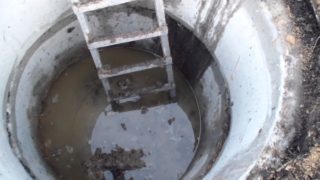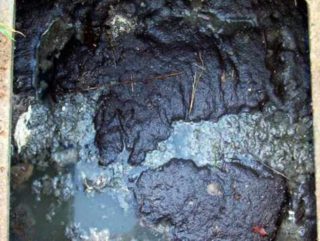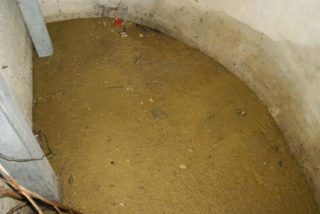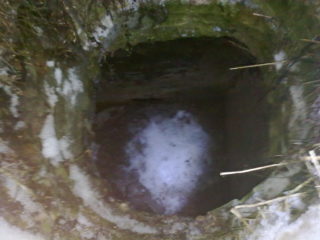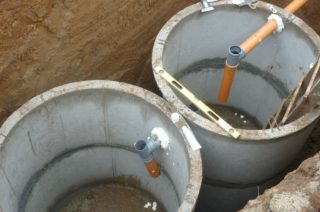A large proportion of private houses in Russia do not have access to centralized sewerage networks. To drain domestic wastewater in such houses, an autonomous system is set up, which, as a rule, consists of a simple cesspool. If the sewer is equipped correctly, then at first it performs its function perfectly. But in the process of prolonged use or due to an increase in the number of people living in the house, there is often a problem with the accelerated filling of the container, which causes a lot of trouble for the owners. Below are the most common causes of this situation and how to fix the problem.
Reasons for fast filling
- Silting up - the bottom and walls of the cesspool are covered with sediments that block the effective absorption of water into the ground;
- Fat - dumping fat from the kitchen into the sewage system leads to the formation of an insoluble film and prevents water from leaving;
- Freezing of waters Is a common problem in regions with harsh winters. The icy is not able to let runoffs pass.
- Inconsistency of volume for needs - the throughput of the septic tank is less than the real volume of effluents leaving the house.
It is worth considering each of the problems outlined in more detail in order to understand the cause of the trouble and find an effective way out of this situation.
Silting up the bottom
Other typical indicators of sludge accumulation are:
- the occurrence of an unpleasant odor from the cesspool;
- sludge can be seen with the naked eye when examining a septic tank.
The presence of the above problems signals that the autonomous sewage system needs thorough cleaning work. You can cope with silt deposits in different ways:
- Manual cleaning... The available liquid is pumped out by a drain pump or scooped out with buckets. The use of a fecal pump with the function of crushing dense masses can significantly facilitate the task. The mass of sludge is removed from the bottom manually, if its density is high, you can use metal brushes. The method is very economical in terms of costs, but rather complicated and time consuming.
- Sewage pumping using a sewage machine. Calling up specialized equipment will make cleaning much easier. It is recommended to perform double pumping - for the first time, the drains accumulated in the pit are removed. The sludge masses are filled with clean water, softened and must also be removed. The method is quite workable, but the regular call of the sewers will cost you a lot of money.
- Dry cleaning. Effectively fights hard deposits. It is important to remember that leaving the "chemistry" in the pit is not safe for the environment. Substances can enter the soil, causing subsequent problems with the cultivation of horticultural crops in the local area; or reach sources of water, then it will become undrinkable and irrigated. Therefore, chemically treated wastewater must be pumped out, after which the septic tank will become safe again and will perform its functions more intensively.
- Use of biologically active substances for the decomposition of sludge masses.Both liquid and powder forms are commercially available, which must be dissolved in water and introduced into a sewer pit. The bacteria and microorganisms contained in such products can soften the sludge crust, reduce its amount and, with regular use, remove unpleasant odors. There is an important nuance - microorganisms are effective only at temperatures above +5 degrees, which means that other methods will have to be used to clean sludge in the cold season. Another feature is that bacterial colonies work only when a certain concentration is reached. You will have to periodically add biologicals to the drain.
Body fat
All the same biological products with live bacteria will help to cope with such a problem, they decompose fat deposits well and prevent the formation of new ones.
The use of caustic soda is no less effective, but it must be borne in mind that if the volume of the waste pit is large, then a lot of chemical will be needed. In addition, its use is unsafe for humans and the environment; it is necessary to work with the product with extreme caution, since it is a strong alkali. To work with the substance, rubber gloves are required, as well as a respirator and goggles. Caustic is free-flowing, but it is added directly to the septic tank only after preliminary dissolution in water. It acts quickly, literally within 5 minutes. Then the resulting mass must be pumped out, after which a double rinsing of the pit with clean water is performed.
A very effective preventive measure is the installation of a grease trap in the kitchen. The smart device is mounted under the sink and prevents grease from entering the wastewater.
Freezing waste water
- using a soldering iron;
- using a heat gun or industrial hair dryer;
- using special means for melting ice - special liquids and powders melt ice and prevent its subsequent formation.
It is believed that if the pit is initially correctly arranged (the depth of freezing of the soil is taken into account and there is sufficient volume), it will not freeze completely, an ice crust forms only on the surface. You can resort to additional insulation of the pit, this will help to avoid further problems with its freezing.
Inconsistency in the volume of the drain pit
- the existing sump is concreted, becoming sealed;
- a second pit is being equipped next to it, which will be connected to the first one using an overflow system;
- then in the first "chamber" primary effluents will accumulate, from which the liquid fraction will flow into the next tank.
- the thus obtained clarified wastewater without solid content will be easily absorbed into the ground.
If the free space on the local area allows, many will prefer to dig a new sump rather than tinker with the old one.Nevertheless, it is better to immediately correctly equip a place for domestic wastewater and use it wisely, this will help to avoid problems in the future.

